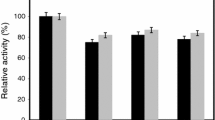Summary
Spores of Rhizopus stolonifer were immobilized aseptically by entrapment with photo-crosslinkable resin prepolymers, urethane prepolymers or several kinds of polysaccharides. The entrapped spores were allowed to germinate and develop in situ. The immobilized living mycelia so obtained were induced for the steroid 11α-hydroxylation system and examined for their activity to hydroxylate progesterone at 11α-position in a buffer system containing 2.5% of organic cosolvent. Of various water-miscible organic cosolvents, methanol was found to be most effective in terms of the activity of the entrapped mycelia and the solubility of the product, 11α-hydroxyprogesterone. Though all the living mycelia entrapped in different gels exhibited the hydroxylation activity, mycelia entrapped in photo-crosslinked gels showed the maximum activity which was rather higher than that of the free mycelia. The net-work size of the photo-crosslinked resins, namely the chain length of the photo-crosslinkable resin prepolymers, affected markedly the mycelial growth in gels, and subsequently, the hydroxylation activity of the entrapped mycelia. Entrapment significantly enhanced the operational activity and stability of the 11α-hydroxylation system in the mycelia, and permitted the intermittent reactivation of the system by incubating the entrapped mycelia in potato-dextrose broth.
Similar content being viewed by others
References
Chun YY, Iida M, Iizuka H (1981) Studies on microbial transformations XIX. Use of immobilized cells of Streptomyces roseochromogenes for the 16α-hydroxylation of dehydroepiandrosterone. J Gen Appl Microbiol 27:505–509
Fukui S, Omata T, Yamane T, Tanaka A (1980a) Application of immobilized biocatalysts to bioconversion in hydrophobic conditions. Enzyme Engineering 5:347–353
Fukui S, Sonomoto K, Itoh N, Tanaka A (1980b) Several novel methods for immobilization of enzymes, microbial cells and organelles. Biochimie 62:381–386
Fukui S, Tanaka A (1982) Immobilized microbial cells. Ann Rev Microbiol 36:145–172
Hanisch WH, Dunnill P, Lilly MD (1980) Optimization of the production of progesterone 11α-hydroxylase by Rhizopus nigricans. Biotechnol Bioeng 22:555–570
Maddox IS, Dunnill P, Lilly MD (1981) Use of immobilized cells of Rhizopus nigricans for the 11α-hydroxylation of progesterone. Biotechnol Bioeng 23:345–354
Ohlson S, Flygare S, Larsson PO, Mosbach K (1980) Steroid hydroxylation using immobilized spores of Curvularia lunata germinated in situ. Eur J Appl Microbiol Biotechnol 10:1–9
Omata T, Iwamoto N, Kimura T, Tanaka A, Fukui S (1981) Stereoselective hydrolysis of dl-menthyl succinate by gelentrapped Rhodotorula minuta var. texensis cells in organic solvent. Eur J Appl Microbiol Biotechnol 11:199–204
Peterson DH, Murray HC, Eppstein SH, Reineke LM, Weintraub A, Meister PD, Leigh HM (1952) Microbiological transformations of steroids. I. Introduction of oxygen at carbon-11 of progesterone. J Am Chem Soc 74:5933–5936
Sedlaczek L, Jaworski A, Wilmanska D (1981) Transformation of steroids by fungal spores. 1. Chemical changes of Cunninghamella elegans spores and mycelium during cortexolone hydroxylation. Eur J Appl Microbiol Biotechnol 13:155–160
Sonomoto K, Hoq MM, Tanaka A, Fukui S (1981) Growth of Curvularia lunata spores into mycelial form within various gels, and steroid 11β-hydroxylation by the entrapped mycelia. J Ferment Technol 59:465–469
Sonomoto K, Hoq MM, Tanaka A, Fukui S (1982) 11β-Hydroxylation of cortexolone (Reichstein's Compound S) to hydrocortisone by Curvularia lunata entrapped in photo-crosslinked gels. Appl Environ Microbiol in press
Sonomoto K, Jin I-N, Tanaka A, Fukui S (1980) Application of urethane prepolymers to immobilization of biocatalysts: Δ1-Dehydrogeneration of hydrocortisone by Arthrobacter simplex cells entrapped with urethane prepolymers. Agric Biol Chem 44:1119–1126
Sonomoto K, Tanaka A, Omata T, Yamane T, Fukui S (1979) Application of photo-crosslinkable resin prepolymers to entrap microbial cells. Effects of increased cell-entrapping gel hydrophobicity on the hydrocortisone Δ1-dehydrogeneration. Eur J Appl Microbiol Biotechnol 6:325–334
Tanaka A, Yasuhara S, Osumi M, Fukui S (1977) Immobilization of yeast microbodies by inclusion with photo-crosslinkable resins. Eur J Biochem 80:193–197
Yokozeki K, Yamanaka S, Takinami K, Hirose Y, Tanaka A, Sonomoto K, Fukui S (1982a) Application of immobilized lipase to regio-specific interesterification of triglyceride in organic solvent. Eur J Appl Microbiol Biotechnol 14:1–5
Yokozeki K, Yamanaka S, Utagawa T, Takinami K, Hirose Y, Tanaka A, Sonomoto K, Fukui S (1982b) Production of adenine arabinoside by gel-entrapped cells of Enterobacter aerogenes in water-organic cosolvent system. Eur J Appl Microbiol Biotechnol 14:225–231
Author information
Authors and Affiliations
Rights and permissions
About this article
Cite this article
Sonomoto, K., Nomura, K., Tanaka, A. et al. 11α-Hydroxylation of progesterone by gel-entrapped living Rhizopus stolonifer mycelia. European J. Appl. Microbiol. Biotechnol. 16, 57–62 (1982). https://doi.org/10.1007/BF00500727
Received:
Issue Date:
DOI: https://doi.org/10.1007/BF00500727




